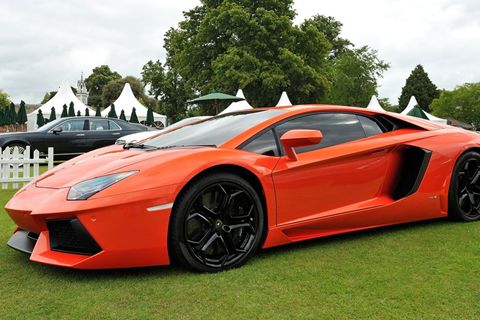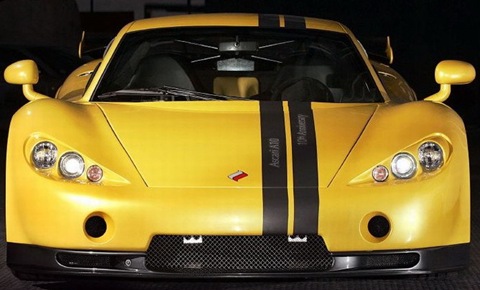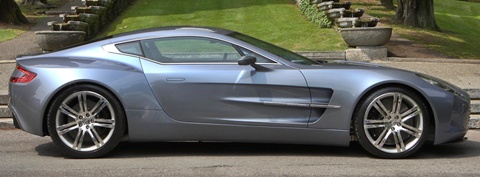

You, the avid reader, are no doubt aware that we recently hosted a little dust-up between the 2013 SRT Viper GTS and the 2013 Chevrolet Corvette ZR1 that ended with the outgoing ZR1 setting a new lap record at Mazda Raceway Laguna Seca. Much hand-wringing and explanation-giving ensued with regard to the worse-than-expected performance of that “pre-production” Viper GTS. But was the GTS the right model for the test? Vipers of old didn’t give you a lot of options, short of the race-ready ACR model. For the fifth generation, though, SRT has decided to do a significant two-model split. For the racer, the base model gives you all the thrills and few of the frills. If you like leather seats and contrast stitching, get the fancier GTS model.

Until now, all our testing has been done on the GTS. This isn’t unusual, as automakers like to get their fanciest model out to the press first to dazzle us with all the features. In truth, the extra weight of some leather and do-dads shouldn’t meaningfully affect performance on a 640-horsepower car. Nevertheless, we felt it our duty to test the base SRT model as well, just to make sure. SRT is pitching this car as the highest-performing car under $100,000. At $99,390 to start, it’s an optional paint color away from breaking the C-note mark, and there are only three no-cost colors. Unfortunately, there’s the small matter of the gas guzzler tax, which pushes the price to $101,990 out the door. Our tester also sported a $500 set of polished wheels, but other than that, it was as base as it could get. So technically, it’s only an under-$100,000 car before tax, but never mind that. Is it the best?

Well…no. Sort of. It depends. Brace yourselves, kids, because there’s some hair-splitting coming here. You see, there’s the small matter of the Chevrolet Corvette Z06/Z07. That car, with its Michelin Pilot Sport Cup Zero Pressure tires, laid down a lap time of 1:34.43 back at Best Driver’s Car 2011. That’s two-tenths quicker than the SRT. Here’s where the debates start. That specific Z06 was optioned up over $100,000, and there’s the small matter of it now being out of production, so you can’t buy a new one like you can the SRT Viper. On the other hand, a base Z06 was $76,595 and with just the Z07 package and related performance gear, you could get one out the door for just under $83,000. Then there’s the matter of the performance. The Z06 was slightly slower to 60 mph (3.8 seconds) and through the quarter mile (11.9 seconds at 122.5 mph), but it pulled 1.13 g average on the skidpad, lapped the figure eight in 22.8 seconds at 0.98 g average, and stopped from 60 mph in just 94 feet. But to get the faster lap time out of the Viper, you need the $3500 Track Package, which puts you well over $100,000. Of course, you’re technically over $100,000 with the gas guzzler tax anyway. So which was the highest-performing car for under $100,000? A month or two ago, when both cars were technically on sale, that would be a tough call depending on how you weighted your performance criteria, but since the Z06 is gone now, the SRT wins by default. Barely.
The good news, then, is that the base SRT is a very good car. As noted, Randy found it to be a better track car than the GTS, thanks to its softer rear suspension (softer by race car driver standards, that is), which translated to more grip from the rear tires. Taking a hot lap with Randy at the wheel, I found it stunning how hard he was able to push the SRT even on the base tires without the famously volatile car trying to bite him. I tried it myself, and never experienced any real under- or oversteer at don’t-stuff-it-into-a-tire-wall speeds. I’ve spun older Vipers and was understandably concerned about doing the same in this new car, but the performance greatly exceeded my expectations. That said, Randy did have some reservations. “There’s a very narrow envelope you can drive the Viper in,” he said. “If you get into the throttle too quickly, it’ll come out on you quick and the only way to fix it is to back out of the throttle. There’s rotation, but you can’t use it. Other cars, you can use the rotation to point you out of the corner. Not this car. “I had to slow my hands down. Slow, smooth inputs, because it’s got great grip in the front and it turns in quickly. Slow hands, except when it comes loose. Then you have to be real quick or you’re gonna lose it.”

“You remember the 911 from Best Driver’s Car?” Randy asked me. “That car was so consistent. I could get every corner perfect. The Viper’s not like that. Each corner I’m going, ‘Am I gonna get it right, am I gonna get it right, OK, I got it right, what about the next corner, am I gonna get it right, no, I didn’t get it right.’ I can’t get a perfect lap with the Viper.”
But, I asked, are these Vipers better than the one we tested against the ZR1? “Absolutely!” Randy said. “They’re much better. It’s way more hooked-up. I just think there’s a little more there they could get and really nail this thing down.” In other words, it’s still a Viper underneath it all. For the faithful, that’s good news, but there’s good news for the rest of us, too. The new Viper is as good at $99,000 as it is at $140,000; it’s more rewarding for a driver new to the car; it’s a higher-quality car than it used to be in every regard; and it’s even easier to drive on the street. (It has a better ride and a lighter clutch than old models.) The highest-performing car under $100,000? Close enough.
- Let’s see how the Viper performed, then. As it happens, we also had a production-spec GTS with us, so we’ll compare it to its high-dollar brother first. The base SRT hit 60 mph in 3.5 seconds, a tenth of a second behind the GTS. The same thing happened in the quarter mile, where the base car trapped in 11.5 seconds at 128.7 mph, a tenth of a second behind the GTS. In trap speed, the SRT was a tenth of a mile per hour faster than the production-spec GTS and a tenth of a mile per hour slower than the pre-production GTS. Pulling 1.04 g average on the skidpad, the SRT was barely out-gripped by the GTS at 1.05 g average. Oddly enough, the GTS was a tenth of a second quicker around the figure-eight test at 23.3 seconds to the SRT’s 23.4, but the SRT pulled higher average g at 0.93 to the GTS’ 0.91. The only substantial difference in performance between the two cars was in braking, where the SRT stopped 5 feet shorter, needing only 99 feet to stop from 60 mph to the GTS’ 104. That pre-production GTS, though, was on Pirelli P Zero Corsa tires, while the production GTS and the SRT were both on standard P Zeros. In case you’re wondering, the pre-production GTS and its stickier tires pulled 1.08 g on the skidpad and ran the figure eight in 23.2 seconds at 0.91 average .But wait, there’s more. You see, we also took these beasts back to Mazda Raceway Laguna Seca to see what they’d do at the track. And it got interesting. The Corsa-tired, pre-production GTS, as you may recall, lapped the famed circuit in 1:35.8. The production-spec GTS on P Zeros just edged it at 1:35.78, but the SRT and its non-adjustable suspension (the GTS gets two-mode electronically controlled dampers) pulled off a 1:35.37.Then it got even more interesting. As it happens, we had a set of the Viper’s optional P Zero Corsa tires with us, and we ran them on both cars. The result: 1:34.63 for the SRT and 1:34.23 for the GTS. How did that happen? Even hot shoe Randy Pobst was confused. “I liked the SRT better,” said Pobst. “The rear end of the GTS was still too loose. I felt faster in the SRT.”..
-

- We took a look at the telemetry and the difference, it seems, was actually in the brakes. The GTS was equipped with the optional Track Package, which among other things upgrades the brakes with lighter, slotted, two-piece, StopTech rotors. Normally, we wouldn’t expect upgraded rotors to have a big effect, but the data showed that Randy was consistently braking slightly later in the GTS than the SRT, which earned him the extra tenths at the finish line. Of course, we’re talking tenths of a second here, which can be earned or lost in one good or bad corner. We’ve established, then, that both the SRT and GTS Vipers, in their full production spec with final suspension tuning and optional tires, are faster on the track than previously observed. Not fast enough to take the lap record from the defunct Corvette ZR1, but not as slow as previously observed. What, then, about that other claim? Best performer under 100k?



Well…no. Sort of. It depends. Brace yourselves, kids, because there’s some hair-splitting coming here. You see, there’s the small matter of the Chevrolet Corvette Z06/Z07. That car, with its Michelin Pilot Sport Cup Zero Pressure tires, laid down a lap time of 1:34.43 back at Best Driver’s Car 2011. That’s two-tenths quicker than the SRT. Here’s where the debates start. That specific Z06 was optioned up over $100,000, and there’s the small matter of it now being out of production, so you can’t buy a new one like you can the SRT Viper. On the other hand, a base Z06 was $76,595 and with just the Z07 package and related performance gear, you could get one out the door for just under $83,000. Then there’s the matter of the performance. The Z06 was slightly slower to 60 mph (3.8 seconds) and through the quarter mile (11.9 seconds at 122.5 mph), but it pulled 1.13 g average on the skidpad, lapped the figure eight in 22.8 seconds at 0.98 g average, and stopped from 60 mph in just 94 feet. But to get the faster lap time out of the Viper, you need the $3500 Track Package, which puts you well over $100,000. Of course, you’re technically over $100,000 with the gas guzzler tax anyway. So which was the highest-performing car for under $100,000? A month or two ago, when both cars were technically on sale, that would be a tough call depending on how you weighted your performance criteria, but since the Z06 is gone now, the SRT wins by default. Barely.
The good news, then, is that the base SRT is a very good car. As noted, Randy found it to be a better track car than the GTS, thanks to its softer rear suspension (softer by race car driver standards, that is), which translated to more grip from the rear tires. Taking a hot lap with Randy at the wheel, I found it stunning how hard he was able to push the SRT even on the base tires without the famously volatile car trying to bite him. I tried it myself, and never experienced any real under- or oversteer at don’t-stuff-it-into-a-tire-wall speeds. I’ve spun older Vipers and was understandably concerned about doing the same in this new car, but the performance greatly exceeded my expectations. That said, Randy did have some reservations. “There’s a very narrow envelope you can drive the Viper in,” he said. “If you get into the throttle too quickly, it’ll come out on you quick and the only way to fix it is to back out of the throttle. There’s rotation, but you can’t use it. Other cars, you can use the rotation to point you out of the corner. Not this car. “I had to slow my hands down. Slow, smooth inputs, because it’s got great grip in the front and it turns in quickly. Slow hands, except when it comes loose. Then you have to be real quick or you’re gonna lose it.”

“You remember the 911 from Best Driver’s Car?” Randy asked me. “That car was so consistent. I could get every corner perfect. The Viper’s not like that. Each corner I’m going, ‘Am I gonna get it right, am I gonna get it right, OK, I got it right, what about the next corner, am I gonna get it right, no, I didn’t get it right.’ I can’t get a perfect lap with the Viper.”
But, I asked, are these Vipers better than the one we tested against the ZR1? “Absolutely!” Randy said. “They’re much better. It’s way more hooked-up. I just think there’s a little more there they could get and really nail this thing down.” In other words, it’s still a Viper underneath it all. For the faithful, that’s good news, but there’s good news for the rest of us, too. The new Viper is as good at $99,000 as it is at $140,000; it’s more rewarding for a driver new to the car; it’s a higher-quality car than it used to be in every regard; and it’s even easier to drive on the street. (It has a better ride and a lighter clutch than old models.) The highest-performing car under $100,000? Close enough.
| 2013 SRT Viper | 2013 SRT Viper GTS | |
| BASE PRICE | $101,990 | $124,990 |
| PRICE AS TESTED | $102,490 | $143,090 |
| VEHICLE LAYOUT | Front-engine, RWD, 2-pass, 2-door coupe | Front-engine, RWD, 2-pass, 2-door coupe |
| ENGINE | 8.4L/640-hp/600-lb-ft OHV 20-valve V-10 | 8.4L/640-hp/600-lb-ft OHV 20-valve V-10 |
| TRANSMISSION | 6-speed manual | 6-speed manual |
| CURB WEIGHT (F/R DIST) | 3343 lb (50/50%) | 3362 lb (50/50%) |
| WHEELBASE | 98.8 in | 98.8 in |
| LENGTH x WIDTH x HEIGHT | 175.7 x 76.4 x 49.1 in | 175.7 x 76.4 x 49.1 in |
| 0-60 MPH | 3.5 sec | 3.4 sec |
| QUARTER MILE | 11.5 sec @ 128.7 mph | 11.4 sec @ 128.6 mph |
| BRAKING, 60-0 MPH | 99 ft | 104 ft |
| LATERAL ACCELERATION | 1.04 g (avg) | 1.05 g (avg) |
| MT FIGURE EIGHT | 23.4 sec @ 0.93 g (avg) | 23.3 sec @ 0.91 g (avg) |
| 2.2-MI ROAD COURSE LAP | 1:35.37 (Pzero); 1:34.63 (Pzero Corsa) | 1:35.78 (Pzero); 1:34.23 (Pzero Corsa) |
| EPA CITY/HWY FUEL ECON | 12/19 mpg | 12/19 mpg |
| ENERGY CONS., CITY/HWY | 281/177 kW-hrs/100 miles | 281/177 kW-hrs/100 miles |
| CO2 EMISSIONS | 1.35 lb/mile | 1.35 lb/mile |








































.jpg)















































